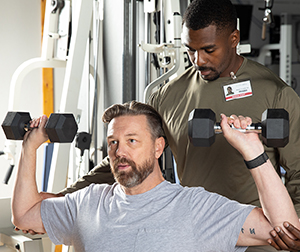A
B
C
D
E
F
G
H
I
J
K
L
M
N
O
P
Q
R
S
T
U
V
W
X
Y
Z
Back to Intro
Click a letter to see a list of medical procedures beginning with that letter.
Click 'Back to Intro' to return to the beginning of this section.
Physical Fitness and Spinal Cord Injury (SCI)
You may think that you can’t be physically fit with a spinal cord injury (SCI). But you can indeed exercise, be active, and build and maintain fitness. Exercise plays a very important role in keeping you healthy.
How exercise helps
Exercise offers people with SCI many benefits. It helps you:
-
Feel better. Exercise can help ease feelings of depression, anger, and anxiety. It can also help relieve stress. And it helps many people sleep better.
-
Have more independence. Exercise helps keep your muscles strong. It gives you more energy. It also helps manage your weight. All of these things make mobility easier. This helps you maximize your independence.
-
Stay healthy. Exercise helps prevent illnesses, like colds and the flu. It can also help prevent heart disease, high blood pressure, stroke, diabetes, and some cancers. It helps improve skin health, making pressure sores less likely. And it can lower your risk for injuries and complications. It will also reduce specific issues that are increased in SCI such as constipation and respiratory infections.
A fitness plan that works for you
There are many kinds of exercises. The ones that will work best for you will depend on your site of injury. Your exercise program may include strength training, aerobic exercise, stretching, and breathing exercises. You may work on machines or with small devices or accessories. You may exercise at home or in a facility. Members of your healthcare team, such as a physical therapist (PT) or occupational therapist (OT), will help you find the exercises that work best for you.
 |
| Your exercise program may include upper-body workouts. |
Getting involved in sports
Many people with SCI also enjoy playing sports. These sports include adaptive basketball, swimming, tennis, softball, rowing, and many more. Talk with your PT or OT if you are interested in sports. They can help you find local resources. You can also search the keywords “adaptive sports” on the Internet to find resources in your area.
Exercising safely
To exercise safely, follow these steps:
-
Talk with your PT, OT, or healthcare provider. Do this before starting or changing an exercise program. Learn which exercises are best for you.
-
Start slowly. Get used to the exercises first. Over time, you can work harder at the exercises.
-
Pay attention to pain. Be aware of pain in your hands, arms, and shoulders. Injuries in these areas can affect your daily activities and self-care.
-
Check your blood pressure. Be alert for symptoms of autonomic dysreflexia (AD). You may need to adjust your exercise to relieve symptoms or prevent AD.
-
Protect your skin. Take steps to prevent pressure sores and other injury. Use cushions and shift your weight to relieve pressure.
-
Protect your bones. People with SCI can have thinner bones. Take care not to fall when exercising.
-
Use safety accessories. These may include tape, straps, and padding.
-
Watch your temperature. Your body is less able to maintain its own temperature. Stay aware of how you feel and stop if you get too hot.
-
Manage your bladder and bowel. Keep to your routine to avoid accidents or AD. Empty your bladder or bag before you exercise.
-
Drink plenty of water. Adjust your bladder routine as needed.
-
Ask for help. Speak up as soon as you need assistance of any kind.
Progress takes time
Becoming active again can be difficult and frustrating at first. Start slowly. Do short, easier exercises at first. Build up to more exercise as you feel able. In time, you’ll have more strength, stamina, and confidence.
A lifelong goal
Keeping fit is a lifelong goal. Working at it every day will make it easier. If you need help along the way, don’t hesitate to ask for it. Get support from your family, friends, and caregivers. And talk to your healthcare team before beginning any exercises and whenever you have questions or need assistance. They are there to help you be healthy, strong, and fit.
Online Medical Reviewer:
Anne Fetterman RN BSN
Online Medical Reviewer:
Marianne Fraser MSN RN
Online Medical Reviewer:
Rita Sather RN
Date Last Reviewed:
3/1/2024
© 2000-2024 The StayWell Company, LLC. All rights reserved. This information is not intended as a substitute for professional medical care. Always follow your healthcare professional's instructions.